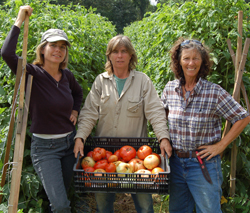For the rest of the summer, we’ll be revisiting previous episodes of Last Chance Foods.
Europeans used to believe that eating so-called “mad apples” caused insanity, leprosy and bad breath. Fortunately, these days, we know that eggplant is a healthy, delicious vegetable used in everything from eggplant parmesan to Thai curries.
Gail Hepworth, the production manager of Hepworth Farms in Milton, N.Y., is a particular fan of the vegetable. Her farm grows more than 15 types of eggplant for community supported agriculture groups and the Park Slope Food Co-op.
Hepworth thinks that eggplant’s negative association might have been caused by its mild toxicity. Like tomatoes, peppers, potatoes and other nightshade vegetables, eggplant contains solanin, an alkaloid that can be toxic in large quantities. Younger eggplants tend to have more solanin, but unless you’re particularly sensitive to it, you’d have to eat about 36 raw eggplants for solanin levels to be dangerous.
The vegetable is particularly good right now in early fall, when it’s at the peak of its season.
The large, oblong, deep purple, Italian type is most well-known to Americans, but eggplants come in a wide variety of colors — from white and yellow to red and purple — and as many sizes and shapes.
“I keep hearing that eggplant was white traditionally and historically, and it evolved to have color,” said Hepworth, adding that white eggplants bruise easily and that might have been one reason dark-colored eggplants became more popular.
“In fact, maybe that name eggplant came from little round, white eggplants,” Hepworth surmised, adding that the white eggplants have an advantage when it comes to taste, as well. “It’s has no [bitterness]. It’s mild, sweet, creamy.” 
While some may dislike the bitter quality of some eggplants, Hepworth admits that it’s a taste she doesn’t mind. “I have never salted an eggplant to take the bitterness out... or pounded,” she said. “But I know that a lot of Italians do that.”
(Photo: Gail Hepworth, Amy Hepworth, and Gerry Greco of Hepworth Farms/Courtesy of Hepworth Farms)
That’s one step that’s easy to skip. For those looking for an even easier way to cook eggplant, Hepworth recommended the small, purple- and white-striped fairy tale eggplants that are about one- to three-inches long.
“They’re so quick to cook,” she said. “If you put them under the grill or you just put them in the oven, they would be ready in a couple of minutes.”
Eggplant is also easy farmers and gardeners.
“It’s not really that hard to grow,” said Hepworth. “We actually kind of ignore the eggplant and it just keeps coming.”
Hepworth said that she’s a fan of roasting eggplant with tomatoes, but that she doesn’t get much time to cook during the harvest season. Instead, she shared two recipes for eggplant caponata from her favorite restaurants in the Hudson Valley.
Check those out below, and let us know which one you like better. Also, do you salt or pound your eggplant to eliminate bitterness? Tell us in the comments section.
Global Palate’s Eggplant Caponata
by Jessica Winchell, Chef-Owner of The Global Palate Restaurant
- 1 medium eggplant, diced
- 1 yellow squash, diced
- 1 zucchini, diced
- 1 medium onion, diced
Sautee in 1/4 c. olive oil until soft.
Add:
- 1 tablespoon diced garlic
- 1 cup puree peeled fresh tomatoes,
- 1/2 cup cider vinegar
- 1/2 cup brown sugar
- 1/2 cup raisons
- 2 tbsp. diced basil
Cook for 15 minutes
To be served over fish, as a cold dip, or on pasta or polenta.
The Artist’s Palate Eggplant Caponata
by Megan and Charles Fells Jr., chef-owners of The Artist’s Palate
serves 6-8
- 3 cups olive oil
- 2 lbs. eggplant, cut into 1″ cubes
- 2 red bell peppers diced
- 1 large yellow onion, chopped
- 1 rib celery, roughly chopped
- Kosher salt and freshly ground black pepper, to taste
- 3 tbsp. tomato paste, thinned with 1/4 cup water
- 1 cup crushed canned tomatoes
- 6 oz. green olives, pitted and roughly chopped
- 1/2 cup white wine vinegar
- 1/2 cup golden raisins
- 1/4 cup salt-packed capers, rinsed and drained
- 3 tbsp. sugar
- 2 tbsp. finely grated unsweetened chocolate
- 1/2 cup finely shredded basil
- 2 tbsp. pine nuts
Heat oil in a 12 inch skillet over medium-high heat. Working in batches, add eggplant and fry, tossing occasionally, until browned, 3–4 minutes. Using a slotted spoon, transfer eggplant to a large bowl; set aside. Pour off all but 1/4 cup oil, and reserve for another use. Return skillet to heat, add onions and celery, and season with salt and pepper; cook, stirring often, until beginning to brown, 10 minutes. Reduce heat to medium, and add tomato paste and cook, stirring, until caramelized and almost evaporated, 1–2 minutes. Add crushed tomatoes and continue cooking for 10 minutes. Stir in olives, vinegar, raisins, capers, sugar, and chocolate, and cook, stirring occasionally, until thickened, about 15 minutes. Transfer to bowl with eggplant, along with basil and pine nuts, and mix together. Season with salt and pepper, and let cool to room temperature before serving.